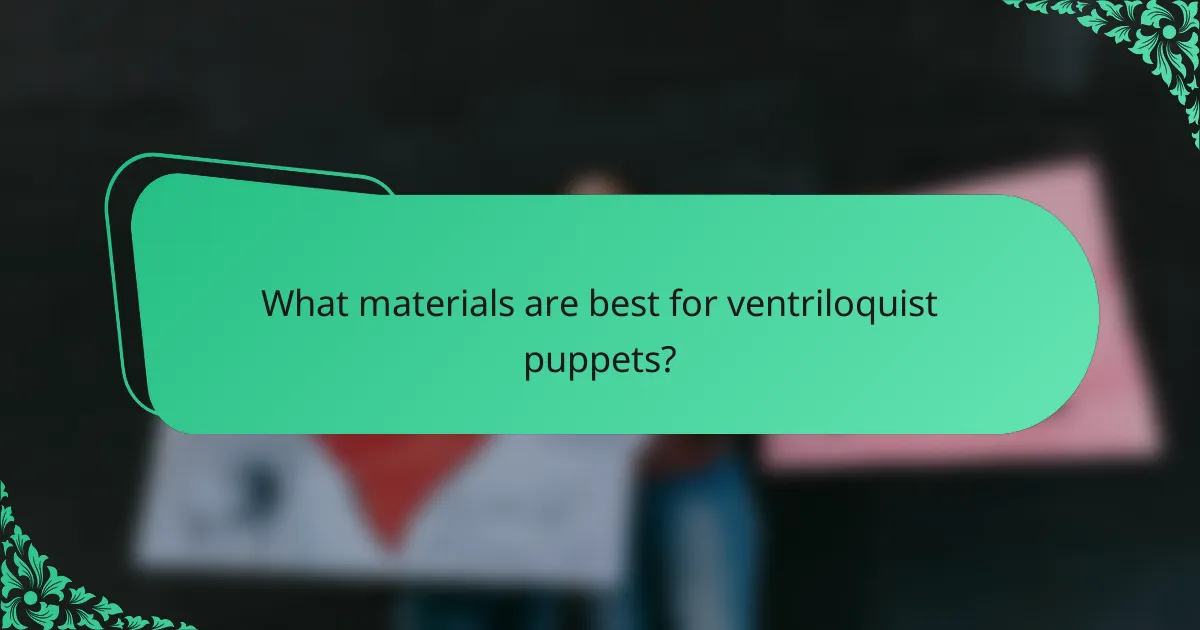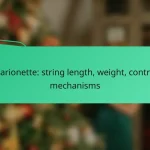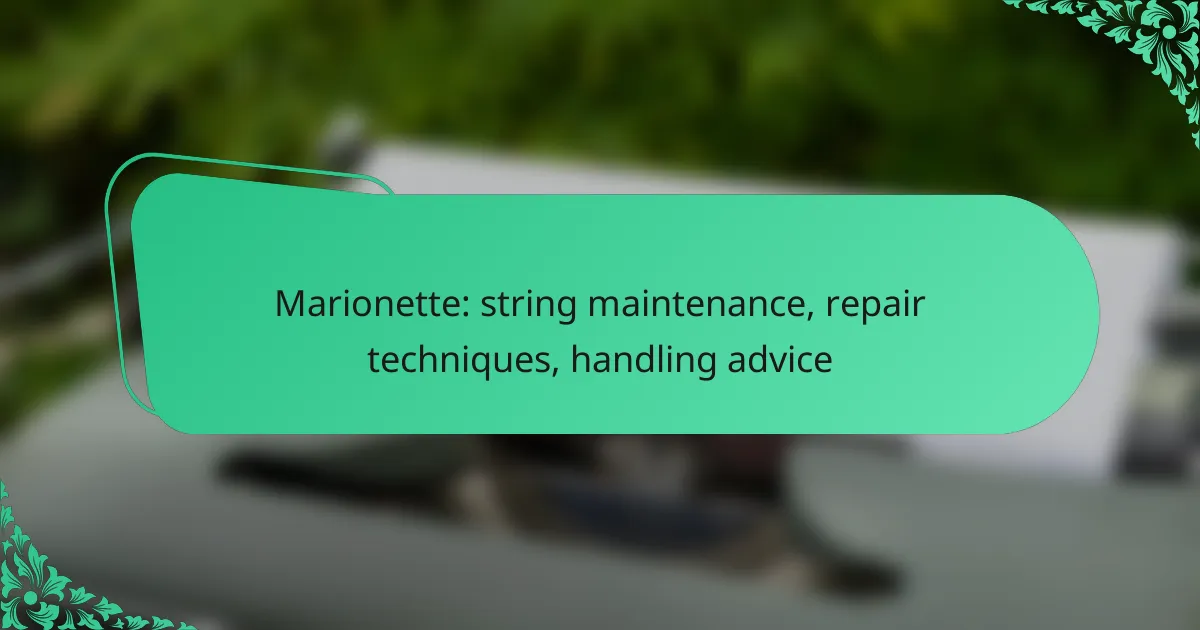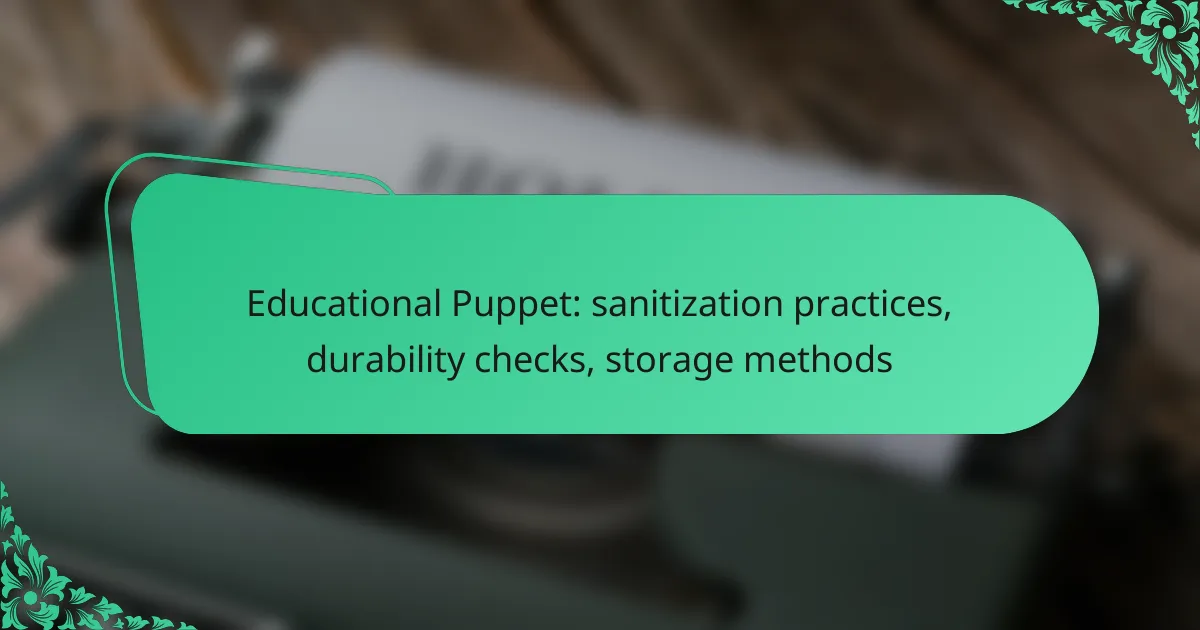Proper care of a ventriloquist puppet’s voice box is crucial for ensuring its functionality and sound quality during performances. Selecting the right materials, such as wood, plastic, or fabric, can enhance durability and ease of use, directly impacting the puppet’s longevity. Regular maintenance, including practice and timely repairs, is essential for keeping your puppet in peak condition for every show.

How to care for a ventriloquist puppet’s voice box?
Caring for a ventriloquist puppet’s voice box is essential for maintaining its functionality and sound quality. Regular maintenance ensures that the voice box operates smoothly and lasts for many performances.
Regular cleaning with gentle solutions
To keep the voice box clean, use a soft, damp cloth with a mild soap solution. Avoid harsh chemicals that could damage the materials or affect the sound quality. Regular cleaning helps prevent buildup of dust and debris that can hinder performance.
Make it a habit to clean the voice box after each performance or at least once a month, depending on usage. This simple practice can significantly extend the life of the puppet’s voice mechanism.
Proper lubrication techniques
Lubrication is crucial for the moving parts of the voice box to function smoothly. Use a small amount of silicone-based lubricant, applying it sparingly to avoid excess buildup. Proper lubrication reduces friction and wear, enhancing the puppet’s vocal performance.
Check the lubrication every few months or whenever you notice any stiffness in movement. Over-lubricating can attract dust, so aim for a light, even application.
Inspection for wear and tear
Regularly inspect the voice box for signs of wear and tear, such as cracks, loose components, or unusual sounds during operation. Pay close attention to the hinges and joints, as these areas are most susceptible to damage.
Conduct thorough inspections at least twice a year, or more frequently if the puppet is used often. Early detection of issues can prevent more significant repairs later on.
Replacement options for damaged components
If you find damaged parts during your inspections, consider replacement options to maintain performance. Many manufacturers offer replacement voice boxes or individual components, making it easier to restore functionality.
When replacing parts, ensure compatibility with your specific puppet model. If unsure, consult the manufacturer or a professional for guidance to avoid mismatches that could affect performance.

What materials are best for ventriloquist puppets?
The best materials for ventriloquist puppets include wood, plastic, and fabric, each offering unique benefits for performance and maintenance. Choosing the right material depends on factors like durability, weight, and versatility, which can significantly impact your puppet’s longevity and ease of use.
Wooden puppets for durability
Wooden puppets are known for their robustness and longevity. They can withstand rough handling and are less likely to break compared to other materials, making them ideal for frequent performances.
However, wooden puppets can be heavier, which may affect the ease of manipulation during shows. Regular maintenance, such as polishing and checking for cracks, can help preserve their appearance and functionality over time.
Plastic puppets for lightweight handling
Plastic puppets are favored for their lightweight nature, making them easy to handle and maneuver during performances. This material is often more affordable and can be produced in various colors and designs, appealing to a wide audience.
While plastic puppets may not be as durable as wooden ones, they are generally resistant to moisture and can be easier to clean. It’s essential to avoid exposing them to extreme temperatures, which can warp or damage the material.
Fabric puppets for versatility
Fabric puppets offer exceptional versatility in design and expression. They can be easily customized with different fabrics, colors, and accessories, allowing for a wide range of character creation.
While fabric puppets may not provide the same level of durability as wood or plastic, they are lightweight and can be more comfortable to use during extended performances. Regular cleaning and proper storage can help maintain their condition and appearance.

How to maintain a ventriloquist puppet’s performance longevity?
To ensure a ventriloquist puppet’s performance longevity, regular maintenance and care are essential. This includes consistent practice, proper storage, and timely repairs to keep the puppet in optimal condition for performances.
Regular practice and performance routines
Engaging in regular practice helps maintain a ventriloquist puppet’s performance quality. Set aside time each week to rehearse scripts and refine techniques, focusing on voice modulation and puppet manipulation.
Incorporate performance routines that simulate real shows. This not only builds your confidence but also allows you to identify any issues with the puppet that may need addressing before a live audience.
Storage tips to prevent damage
Proper storage is crucial for preventing damage to your ventriloquist puppet. Keep the puppet in a cool, dry place away from direct sunlight to avoid fading and warping of materials.
Use a padded case or box for storage to protect against dust and physical impacts. If the puppet has delicate features, consider wrapping it in a soft cloth to provide extra cushioning.
Repair techniques for common issues
Common issues with ventriloquist puppets include loose joints and worn-out voice boxes. For loose joints, use a strong adhesive to reattach any parts that have come apart, ensuring they move smoothly afterward.
If the voice box malfunctions, check for any obstructions or damaged components. Replacement parts are often available through specialty retailers, allowing for easy repairs without needing professional help.

What are the best brands for ventriloquist puppets in Australia?
In Australia, some of the best brands for ventriloquist puppets include Ventriloquist Central and The Puppet Company. These brands are known for their quality craftsmanship and diverse selections, catering to various performance needs and budgets.
Ventriloquist Central for quality options
Ventriloquist Central is renowned for its high-quality puppets that appeal to both beginners and seasoned performers. Their products often feature durable materials and realistic designs, which enhance the overall performance experience.
When choosing a puppet from Ventriloquist Central, consider the size and weight, as these factors can affect your handling during performances. Their puppets typically range from around AUD 100 to AUD 500, depending on the complexity and features.
The Puppet Company for diverse selections
The Puppet Company offers a wide variety of puppets, making it an excellent choice for those seeking unique characters and styles. Their range includes everything from traditional ventriloquist puppets to themed options, allowing performers to find the perfect match for their act.
Prices for puppets from The Puppet Company generally start around AUD 50 and can go up to AUD 300 or more for specialized designs. It’s advisable to explore their catalog to find puppets that suit your performance style and audience appeal.

How to choose a ventriloquist puppet for beginners?
Choosing a ventriloquist puppet for beginners involves considering factors like ease of use, size, weight, and material. These elements can significantly impact your performance and comfort while learning the art of ventriloquism.
Consider ease of use
For beginners, selecting a puppet that is easy to manipulate is crucial. Look for puppets with simple mechanisms that allow for smooth mouth movement and easy control. A puppet that requires minimal effort to operate will help you focus on your performance rather than struggling with the mechanics.
Additionally, consider puppets with lightweight designs. Heavier puppets can be tiring to use for extended periods, especially for those just starting. Aim for puppets that balance functionality with user-friendliness.
Evaluate size and weight
The size and weight of a ventriloquist puppet can affect your ability to perform effectively. A puppet that is too large may be cumbersome, while one that is too small might not be as visually impactful. Generally, a medium-sized puppet is a good choice for beginners, as it offers a balance between visibility and manageability.
Weight is another important factor; lighter puppets are easier to handle and allow for more dynamic performances. Consider trying out different puppets to find one that feels comfortable and allows for natural movement.
Assess material suitability
The material of a ventriloquist puppet can influence its durability and appearance. Common materials include wood, foam, and fabric. Wooden puppets often have a classic look and are quite durable, while foam puppets are lightweight and easier to handle, making them ideal for beginners.
When assessing material, also consider maintenance. Some materials may require special care to keep them in good condition. For instance, fabric puppets might need regular cleaning, while wooden puppets may need occasional polishing. Choose a material that fits your performance style and maintenance preferences.

What are common mistakes in ventriloquist puppet care?
Common mistakes in ventriloquist puppet care include neglecting regular maintenance and using improper storage methods. These oversights can significantly reduce the lifespan and performance quality of your puppet.
Neglecting regular maintenance
Regular maintenance is crucial for keeping a ventriloquist puppet in good working condition. This includes checking the voice box, ensuring the joints move smoothly, and cleaning the exterior to prevent dirt buildup. A simple routine of inspecting and cleaning your puppet every few weeks can help avoid larger issues down the line.
Pay attention to the materials used in your puppet. For example, wooden puppets may require occasional polishing, while fabric puppets should be spot-cleaned to maintain their appearance. Neglecting these tasks can lead to deterioration that affects performance and aesthetics.
Improper storage methods
Storing your ventriloquist puppet improperly can lead to damage and decreased functionality. Avoid placing your puppet in damp or excessively hot environments, as these conditions can warp materials or cause mold. Instead, store your puppet in a cool, dry place, ideally in a protective case or bag.
When storing, ensure that the puppet is not squished or pressed against other objects, which can distort its shape. Consider using a padded container or hanging it up to maintain its form. Taking these precautions can extend the life of your puppet and keep it ready for performance.

How to enhance puppet performance techniques?
Enhancing puppet performance techniques involves mastering voice modulation, timing, and character development. Practicing regularly and understanding your puppet’s mechanics can significantly improve your act.
Voice box care
Proper voice box care is crucial for maintaining the quality of sound produced by your ventriloquist puppet. Regularly check the voice box for any signs of wear or damage, and ensure it is clean and free from debris.
To clean the voice box, use a soft, dry cloth to wipe away dust and moisture. Avoid using harsh chemicals that could damage the materials. If the voice box is malfunctioning, consider consulting a professional for repairs to ensure optimal performance.
Material upkeep
Maintaining the materials of your puppet is essential for its longevity and appearance. Puppets are typically made from wood, fabric, or synthetic materials, each requiring specific care methods.
For wooden puppets, regularly polish with a suitable wood conditioner to prevent cracking. Fabric puppets should be spot cleaned with mild soap and water, while synthetic materials can be wiped down with a damp cloth. Store puppets in a cool, dry place to avoid moisture damage.
Performance longevity
To ensure the longevity of your puppet’s performance, practice consistently and refine your skills. Regular rehearsals can help you identify areas for improvement and keep your act fresh.
Additionally, consider varying your routines to engage your audience better. Avoid overusing the same material, as this can lead to a stale performance. Keep your puppet in good condition, and invest in quality accessories to enhance your overall presentation.










